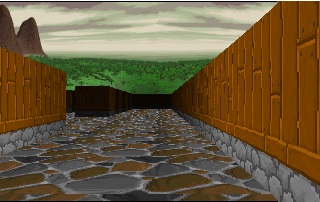Performance really isn't the issue... Here are the changes I have made:
1) I added the ability to have different "wall" types
2) I added a ceiling
3) I allowed for the floor and ceiling to have a different tile than the walls
4) I checked for collision with the wall before allowing you to move (kinda important!)
5) I added a soundtrack. The one I am using is Stones, from Ultima IX
The issue is that, now with different images, I see some "bleeding" on the wall images. For instance, if you look at the following image:
http://www.tidmadt.com/images/new_images/errors.jpg
you can see (where I circle in red) where slices from the wrong image are being rendered. This isn't a problem where ALL the images are the same, but I can't see where the line of sight is failing. As you can see in the code, what I do wherever you check to see if there is a wall (if grid[y][x]==1:) I set "wall_type" to what that wall is (a 1 or 2... wall_type = grid[y][x]) so it SHOULD be the same result for the entire segment of the wall... for some reason, some bands seem to be wrong.
Also, while the walls (resolution wise) seem to be fine, the ceiling and floors don't look right.
I created a GitHub fork of your code (giving you full credit for the original) here:
https://github.com/TIDMADT-SYS/simle-raycast
I have 2 versions there, the FPS (with free movement) and the crawler mode (which locks you into 90 degree turns, and one full grid space in movement)
Hopefully it is something minor... just not knowing that aspect of it as well as you, I can't see where in it the problem rests
Thank you in advance for taking time to look


